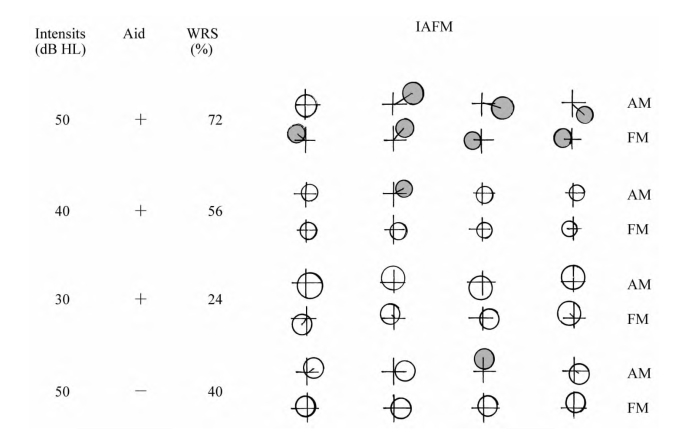五、应用前景
(一)新生儿听力筛查
目前,常用的新生儿听力筛查手段为畸变产物耳声发射、瞬态耳声发射和自动听性脑干反应,耳声发射只能反映外毛细胞的功能,不能检查外毛细胞之后的听觉通路病变,自动听性脑干反应频率特异性差。ASSR具有频率特异性好、能够反映整个听觉系统状态的特点,有可能成为具有频率特异性的新生儿听力筛查工具。
但是ASSR用于新生儿听力筛查尚存在一些问题。1岁以内婴幼儿ASSR的振幅、阈值和可探测性仍在发育变化,不同载频的发育速度不同,高频发育速度快,1岁以内4.0kHz阈值可下降14dB,0.5kHz下降7dB。用2kHz纯音(49dB SPL)进行新生儿快速筛查时,通过率(86%)显著高于用0.5kHz(62dB SPL)筛查(65%),可能与耳蜗和神经系统的发育成熟有关。由于目前缺乏新生儿ASSR阈值数据,故在应用于婴儿之前应作进一步的研究,以确保预估的听力级可靠。
(二)阈上功能测定
听力正常年轻人、老年人和听力下降的老年人的言语识别率与IAFM诱发的调幅和调频反应振幅和有意义反应数均有显著相关性(图9-7)。声强下降、噪声掩蔽和听力下降可以减低言语识别率、调幅和调频反应振幅和反应数,助听器可以增加言语识别率、反应振幅和反应数。故Picton等认为,IAFM反应与声信号改变(强度、掩蔽和放大)、传导性或蜗性听力损失、听神经功能不良(神经瘤、神经病)以及脑干功能障碍引起的言语辨别功能改变有关,指出这种方法有可能成为耳蜗和脑干处理言语信号能力的客观检测方法,可提供言语识别起始阶段所必需的阈上加工的客观数据,对了解受试者言语辨别能力、选择和监测助听器、观察耳蜗置入效果和研究听感知(auditory perception)非常有帮助。如果该方法能够应用于评价言语识别能力将不受年龄、方言和文化程度的影响,可以提供更客观的言语识别功能的数据。
(三)全麻术中监测听觉通路
由于耳蜗和脑干听觉通路很少受麻醉剂的影响,术中可用80Hz反应监测听觉通路的完整性(如听神经瘤切除术),用40Hz反应监测患者意识状态。

图9-7 语言测试及IAMF测试结果
被测者为87岁老年人,其裸耳听力在500、1 000、2 000、4 000Hz处分别为15、20、40、55dBHL。在佩戴助听器后给予50dBHL声音时,言语识别力为72%,同时8个IAFK反应中7个可引出反应;言语识别率越低,反应出现的越少,两者呈正相关关系
(卢云云 郭明丽 李兴启)
参考文献
1 Aoyagi M,Furuse H,Yokota M,et al.Detectability of amplitude-modulation following response at different carrier frequencies.Acta Otolaryngol Suppl,1994,511:23
2 Dalls P.Overview:cochlear neurobiology.The cochlea,ed.R.Fay,New York:Spinger,1996:1-43
3 Dobie R,Wilson MJ.Analysis of auditory evoked potentials by magnitude-squared coherence Ear and Hearing,1989,10:2
4 Dimitrijevic A,John MS,Van Roon P,et al.Human auditory steady-state responses to tones independently modulated in both frequency and amplitude.Ear Hear,2001,22:100
5 Dimitrijevic A,John MS,Picton TW,et al.Auditory steady-state responses and word recognition score in normal-hearing and hearing-impaired adults.Ear Hear,2004,25:68
6 Eybalin M,Altschuler RA.Immunoelectron microscopic localization of neurotransmitters in the cochlea.Journal of Electron Microscopy Technique,1990,15(3):209
7 Gorga MP,Neely ST,Hoover BM,et al.Determining the upper limits of stimulation for auditory steady-state response measurements.Ear Hear,2004,25:302
8 Harrls DM.Action potential suppression,tuning with single fiber data.Hear Res,1979,1:133
9 Harris DM.Action potential suppression tuning with single fiber data.Hear Res,1979,1(2):133
10 Herdman AT,Stapells DR.Thresholds deter-mined using the monotic and dichotic multiple auditory steady-state response technique in normalhearing subjects.Scandinavian Audiology,2001,30:41
11 Herdman AT,Lins O,Van Roon P,et al.Intracerebral sources of human auditory steadystate responses.Brain Topography,2002,15:69
12 Jaramillo F,Wiesenfeld K.Mechanoelectrical transduction assisted by Brownian mation:a role for noise in the auditory system.Nature Neurpossience,1998,95(26):384
13 John MS,Dimitrijevic A,van Roon P,et al.Multiple auditory steady-state responses to AM and FM stimuli.Audiol and Neurootol,2001,6:12
14 John MS,Dimitrijevic A,Picton TW.Efficient stimuli for evoking auditory steady-state responses.Ear Hear,2003,24:406
15 Johnson BW,Weinberg H,Ribary U,et al.Topographic distribution of the 40Hz auditory evoked-related potential in normal and aged subjects.Brain Topogr,1988,1:117
16 Linden RD,Campbell KB,Hamel G.Human auditory steady state evoked potentials during sleep.Ear Hear,1985,6:167
17 Lin X,Chen S.Endogernously generated spontaneous spiking activities recorded from postnatal spiral ganglion neurons in virto.Brain Res Dev Brain Res,2000,119(2):297
18 Lins OG,Picton TW.Auditory steady-state responses to multiple simultaneous stimuli.Eletroencephalogr Clin Neurophysiol,1995,96:420
19 Lins OG,Picton PE,Picton TW,et al.Auditory steady-state responses to tones amplitudemodulated at 80-100Hz.J Acoust Soc Am,1995,97:3051
20 Lins OG,Picton TW,Boucher BL,et al.Frequency-specific audiometry using steady-state responses.Ear Hear,1996,17:81
21 Mauer G,Doring WH.Generators of amplitude modulation following response(AMFR).Paper presented at 16thmeeting of the Evoked Response Auditory Study Group,TromsΦ,Norway,1999
22 Perez-Abalo MC,Savio G,Torres A,et al.Steady state response to multiple amplitudemodulated toneds:An optimized method to test frequency-specific thresholds in hearing-impaired children and normal-hearing subjects.Ear Hear,2001,22:200
23 Picton TW,Vajsar J,Rodriguez R,et al.Reliability estimates for steady-stare evoked potentials.Electroencephalography and Clinical Neurophysiology,1987,68:119
24 Picton TW,Skinner CR,Champagne SC,et al.Potentials evoked by the sinusoidal modulation of the amplitude or frequency of a tone.J Acoust Soc Am,1987,82:165
25 Picton TW,John MS,Dimitrijevic A,et al.Human auditory steady-state responses.Int J Audiol,2003,42:177
26 Picton TW,John MS.Avoiding electromagnetic artifacts when recording auditory steady-state responses.J Am Acad Audiol,2004,15:541
27 Priplate A,Niemi J,Salen M,et al.Noise-enhanced human balance control.[J]Physical Review Letters,2002,89:238 101
28 Rance G,Rickards F W,Cohen L T,et al.The automated prediction of hearing thresholds in sleeping subjects using auditory steady-state evoked potentials.Ear and Hearing,1995,16:499
29 Rance G,Beer DE,Cone-Wesson B,et al.Clinical findings for a group of infants and young children with auditory neuropathy.Ear Hear,1999,20:238
30 Rance G,Briggs RJ.Assessment of hearing in infants with moderate to profound impairment:the Melbourne experience with auditory steadystate evoked potential testing.Ann Otol Rhinol Laryngol,2002,111(suppl 189):22
31 Raphael Y,Altschuler RA.Structure and innervation of the cochlea.Brain Research Bulletin,203,60:397
32 Regan D.Human brain electrophysiology:evoked potentials and evoked magnetic Fields in science and medicine,Amsterdam:Elsevier,1989
33 Rei G,Fu BT.Diagnostic significance of the staggered spondaic word test and 40-Hz auditory event-related potentials.Audiology,1988,27:8
34 Reyes SA,Salvi RJ,Brukard RF,et al.PET imaging of the 40Hz auditory steady state response.Hear Res,2004,194:73
35 Rickards FW,Clark GM.Steady-state evoked potentials to amplitude-modulated tones.In:Nodar RH,Barber C,eds.Evoked potentials II.Boston.Mass:Butterworth,1984:163-168
36 Rickards FW,Tan LE,Cohen LT,et al.Auditory steady-state evoked potential in newborns.Br J Audiol,1994,28:327
37 RoβB,Borgmann C,Draganova R,et al.A high-precision magnetoencephalographic study of human auditory steady-state responses to amplitude-modulated tones.J Acoust Soc Am,2000,108:679
38 Savio G,Cardenas J,Perez-Abalo MC,et al.The low and high frequency auditory steady state responses mature at different rates.Audiol Neurootol,2001,6:279
39 Small SA,Stapells DR.Auditory steady-state responses:Stimulus artifact issues,paper presented at the 2003Meeting of the American Auditory Society,Scottsdale,AZ.
40 Stach B A.Comprehensive dictionary of audiology,1997.Baltimore.Williams and Wilkins.
41 Stapells DR,Gravel JS,Martin BA.Thresholds for auditory brainstem responses to tones in notched noise from infante and young children with normal hearing or sensorineural hearing loss.Ear and Hearing,1995,16:367
42 Valdes J L,Perez-Abalo M C,Martin V,et al.Comparison of statistical indicators for the automatic detection of 80Hz auditory steady state responses.Ear and Hearing,1997,18:420
43 Victor J D,Mast J.A new statistic for steadystate evoked potentials.Electroencephalography and Clinical Neurophysiology,1991,78:378
44 Zhang Cai L,You Guo Q.Stochastic resonance driven be time-modulated neuratrasmitler random trains.[J]Physical Review Letters,2003,91(20):208
45 卢云云,原红艳,赵 晶.多频稳态反应及其应用.听力学及言语疾病杂志,2005,13(1):60
46 李兴启,于 红,曹效平,等.如何认识多频稳态反应(ASSR)在临床应用中存在的问题.中国听力语言康复科学杂志,2006,16(3):10
47 莫玲燕,韩德民,王 琦,等.听力正常成年人同时多频听觉稳态诱发反应研究.听力学及言语疾病杂志,2004,12(6):381
48 邹建华,邱素梅,钟志茹,等.感音神经性聋幼儿多频稳态诱发电位反应阈值与行为测听阈值比较.中国听力语言康复科学,2004,6:30
49 王 坚.声音强度辨别和响度感知.见:王 坚,蒋 涛,曾凡纲主编.听觉科学概论.北京:中国科学技术出版社,2005:360
50 钟志茹,陶 征,邹建华,等.单频和多频刺激的多频稳态反应比较.听力学及言语疾病杂志,2004,12:385
